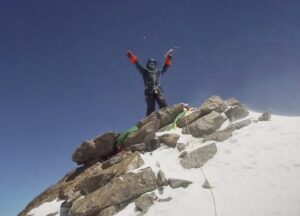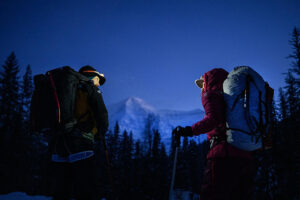With the positive turn in the weather, several alpine-style teams have begun to push up lonely but interesting peaks. With many, even getting there is an adventure.
Aiming for a new route on Kabru South, Peter Hamor, Nives Meroi, Romano Benet, and Bojan Jan needed two weeks just to reach their base camp, at 5,600m up the Yalung Glacier and the Kabru Icefall.
The team left a depot there and retreated to Ramze village for a final rest. They have either begun or are about to start up their new route. They have a long climb ahead, since Kabru South, in the Kangchenjunga region, soars to 7,394m, according to Hamor. (Nepal’s Department of Tourism lists it as 7,318m.)

Kabru Peak, in the Kangchenjunga region. Photo: Peter Hamor
Based on a cryptic message from expedition leader Daijo Saito, it seems that the Japanese team failed to achieve the first ascent of Jarkya Peak in the Manaslu region. “I did all I could and I lost,” wrote Saito. “For the first time, I am alive and with no injuries.”
Further updates to follow.

Daijo Saito on Jarkya Peak. Photo: Daijo Saito/Facebook
Sura Peak
Meanwhile, Marek Holecek and Matej Bernat of the Czech Republic are on their way to Sura Peak. Bernat posted a photo from the 5,360m col called Renjo La today (featured image). He says that Everest is visible in the distance.
“Despite all the controversies around today’s ascents, for me, Everest is still the symbol of Himalayan adventure,” he wrote.
Holecek has not yet decided on the new route he intends to open, but he is already sizing up future goals, including to what he calls the “monster, almost-8,000m, two-horned Gyachung Kang.”
“I’ve been wanting to go to its west face for years,” Holecek admits. “Every time I dwell on the idea, an icy sweat runs down my back. One day, I hope to make up my mind.”
Quiet action, lonely peaks
Other alpine-style expeditions are currently taking place in Nepal, although most teams prefer to keep quiet about their objective until they bring it off. Nepal’s Department of Tourism has issued a number of permits for teams of two or three targeting interesting peaks.
These include:
- Rolwaling’s Tengi Ragi Tau (6,938m). Its first alpine-style climb and second overall ascent earned Alan Rousseau and Tino Villanueva a Piolet d’Or in 2019.
- Tu Tse (6,758m, also known as Peak 6) in Makalu-Barun National Park
- Araniko Chuli (6,034m) near Lo Manthang Pass
- Khatung Khang (6,484m) in the Annapurna region.
- Changwathang and Chandi Himal, neighbors in scarcely visited Western Nepal. According to Nepal Peak Profile, a Japanese team made the first ascent of Changwathan in 2000, while Chandi Himal remains unclimbed. Yet in rarely visited ranges, the names and altitudes of peaks can be confusing. Because of this, their climbing history is not always clear.
Half the fun is getting there
A UK team attempted Chandi Himal in 2013 and reached a 6,024m point on the ridge. At that time, most peaks in the Chandi range (which is what Chandi Himal means) had no name. The only permit available was for a “Chandi Himal peak of 6,069m” (Nepal’s tourism department cites it a little higher, at 6,096m). In fact, Chandi Himal is a whole ridge along the Tibetan border.
“The route up the frontier ridge looked straightforward, so we left all technical gear [behind] and set off unroped along the rocky crest,” member Guy Wilson later wrote in the journal of the American Alpine Club. “At ca. 6,000m, we met an extremely loose section, and with disappointment, retreated to the col. Not wanting to leave empty-handed, we [Wilson, Dave Chapman, and Neil Warren] climbed the northwest ridge of Peak 6,024m on the opposite side of the col, an easy snow dome but the first peak ever climbed in the Chandi Himal.”

One of the 2013 UK team members with steep, rocky Chandi Himal behind. Photo: Guy Wilson/British Mountaineering Council






